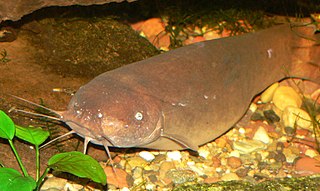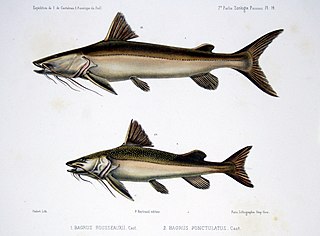
Catfish are a diverse group of ray-finned fish. Named for their prominent barbels, which resemble a cat's whiskers, catfish range in size and behavior from the three largest species alive, the Mekong giant catfish from Southeast Asia, the wels catfish of Eurasia, and the piraíba of South America, to detritivores, and even to a tiny parasitic species commonly called the candiru, Vandellia cirrhosa. Neither the armour-plated types nor the naked types have scales. Despite their name, not all catfish have prominent barbels or "whiskers". Members of the Siluriformes order are defined by features of the skull and swimbladder. Catfish are of considerable commercial importance; many of the larger species are farmed or fished for food. Many of the smaller species, particularly the genus Corydoras, are important in the aquarium hobby. Many catfish are nocturnal, but others are crepuscular or diurnal.

Airbreathing catfish comprise the family Clariidae of the order Siluriformes. Sixteen genera and about 117 species of clariid fishes are described; all are freshwater species. Other groups of catfish also breathe air, such as the Callichthyidae and Loricariidae.

Loricariidae is the largest family of catfish, with 92 genera and just over 680 species. Loricariids originate from freshwater habitats of Costa Rica, Panama, and tropical and subtropical South America. These fish are noted for the bony plates covering their bodies and their suckermouths. Several genera are sold as "plecos", notably the suckermouth catfish, Hypostomus plecostomus, and are popular as aquarium fish.

Clarias is a genus of catfishes of the family Clariidae, the airbreathing catfishes. The name is derived from the Greek chlaros, which means lively, in reference to the ability of the fish to live for a long time out of water.

The Doradidae are a family of catfishes also known as thorny catfishes, raphael catfishes or talking catfishes. These fish are native to South America, primarily the Amazon basin and the Guianas.

The Cetopsidae are a small family of catfishes, commonly called the whale catfishes.

The loach catfishes are a family, Amphiliidae, of catfishes. They are widespread in tropical Africa, but are most common in streams at high elevations; most species are able to cling to rocks in fast-flowing streams. The 13 genera contain 68 species.
The Chiapas catfish, Lacantunia enigmatica, is an unusual species of catfish from the Usumacinta River basin in the Mexican state of Chiapas and in Guatemala. It was scientifically described in 2005 and placed in its own family Lacantuniidae. While discovery of an undescribed species of catfish is not uncommon, discovery of a new family of any vertebrate group is a rare event. The Chiapas catfish mainly feeds on crabs, prawns, small fish, and large, tough plant seeds. This catfish is commonly fished in its natural habitat, where it is known as madre de juil, which means "mother of Rhamdia".
Oreoglanis is a genus of fish in the family Sisoridae native to Asia. These fish live in fast-flowing streams in China, mainland Southeast Asia and the Indian subcontinent. They are mainly distributed in the Mekong, upper Salween and Irrawaddy River drainages. They range from the Brahmaputra basin to the Lam River drainage in central Vietnam. They are easily distinguished from other catfishes by their strongly depressed head and body and greatly enlarged paired fins that have been modified to form an adhesive apparatus. The flattened shape of these fish and the large pectoral and pelvic fins provide essential adhesion in the fast-flowing waters they live in.

Malapterurus is a genus of catfishes of the electric catfish family (Malapteruridae). It includes 18 species.

Phreatobius is a genus of very small catfishes from tropical South America.

Brachyplatystoma is a genus of catfish from the family Pimelodidae. As the occasionally used common name goliath catfishes indicates, this genus includes some of the largest species of catfish, including the piraíba, B. filamentosum, which reaches up to the region of 3.6 metres (12 ft) in length. Brachyplatystoma are found in the Amazon and Orinoco basins, and other tropical freshwater and brackish habitats in South America. Some species are migratory. These fish are important as food fish and, to some extent, aquarium fish.

Hemibagrus is a genus of catfishes of the family Bagridae.

Loricaria is a genus of armored catfish native to South America.

Hemiodontichthys acipenserinus is the only species of the monotypic genus Hemiodontichthys, a genus of the family Loricariidae of catfish.

Helogenes is a genus of whale catfish found in tropical South America.
Micromyzon akamai is a species of catfish in the family Aspredinidae.
Chimarrichthys kishinouyei is a species of sisorid catfish native to Asia.
Siluranodon auritus is the only species in the genus Siluranodon of the catfish family Schilbeidae.
Clarias pseudonieuhofii is a species of clariid catfish from Borneo. It has been currently described from the upper basin of the Kapuas River in West Kalimantan, in a geographic area bordering Sentarum Lake. It has been differed from C. nieuhofii by comparing the holotypes and paratypes from specimens of C. nieuhofii from Sumatra.












